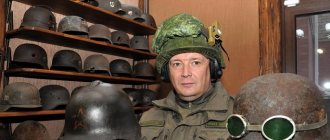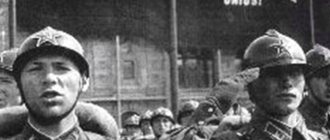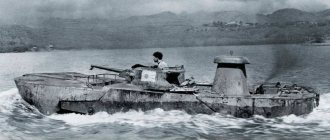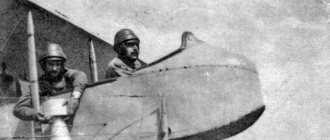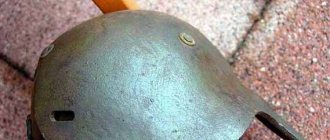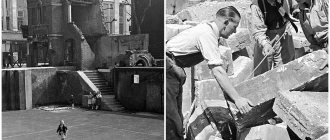Stahlhelm (German: Stahlhelm, “steel helmet”) is an infantry helmet, which under this name is associated primarily with the German armed forces from 1916 to 1945. the pickelhelm*) during the First World War , the stalhelm later became one of the most recognizable attributes of Wehrmacht soldiers.
Since World War I , troops on the battlefield have suffered more casualties from enemy artillery shrapnel and shrapnel, stones, wood chips, and clods of earth than from enemy small arms fire. A helmet does not provide absolute protection in battle; it only increases a fighter’s chances of survival. And it increases quite seriously. The overall percentage of head wounds is significantly reduced.
Historians believe that people began to use protective helmets soon after the appearance of the first weapons, that is, back in the Stone Age. At first they were made from wood, bone, leather... Then man tamed metals and began to make metal helmets. Modifying and improving from era to era, the helmet was present on the battlefield until modern times, but with the spread of firearms, helmets, as well as armor in general, lost their importance. In their place came hats, shakos, caps and other types of headdresses that protected the soldier from the sun and rain, and were part of his uniform.
The military also used helmets, but they were just another element of the dress uniform. These helmets were made of leather, richly decorated, and those serving in such headdresses looked brave and dashing. But such helmets, of course, could not protect the head.
The German politician and military man Otto von Bismarck once loved to show off in an ornate and beautifully decorated picklehelm.
For the longest time, metal protective helmets were used by cuirassiers and dragoons, but they were eventually abandoned there too. Many European countries that had colonies in southern latitudes supplied their armies with pith helmets, but this was protection from the sun, and not from a bullet or saber strike.
At the beginning of the First World War, helmets were in service only with the German army, and even then, the Teutonic “pickelhelm” can hardly be called a helmet in the modern sense of the word.
It was a leather helmet with metal trim and a peaked pommel. It, of course, looked stylish, but the leather was too soft a material and could not protect its owner’s head from splinters and stones. And the high peak and numerous metal parts also gave away the soldier’s location. True, they fought this by using fabric covers.
Pickelhelm in a fabric case
Meanwhile, trench warfare required protection of the head, because it was this part of the body that most often turned out to be an accessible target.
The Germans also made pickelhelms from brass and tin, but it quickly became clear that even metal could not reliably protect the head. The need to adopt a different, more practical helmet became apparent, which was developed in 1915 after research into typical head injuries and the causes that caused them.
Stahlhelm M16 developer Dr. Friedrich Schwerd and the helmet stamping process
The work was supervised by Professor Friedrich Schwerd, who was responsible for the technical part, and military doctor Professor August Bier. The issue was approached with all German thoroughness: helmets of various shapes and designs were tested at the test site. Technical requirements were drawn up for the new product, which related to the thickness and grade of metal, weight, and design. As a result of these researches, the famous Stahlhelm appeared, the most expressive and memorable, thanks to the impeccable plasticity of the lines, during the first half of the 20th century, for many decades it became a real symbol of the German soldier and is associated with Germany and the wars that it fought in the 20th century.
stahlhelm-m16- Steel helmet model 1916.
Its recognizable shape is predetermined by the combination of the volume of a cylindrical body that covers the head and a conical backplate that covers the ears from the impact of sound waves and fragments. The protruding visor gives the helmet an aggressive, predatory shape. The first examples of such helmets were put into service in 1916 under the designation Stahlhelm M16 (“Steel helmet, model 1916”) or M1916. They were received by soldiers of assault units, snipers, sappers, and observers. The M16 was made from a hardened silicon-manganese-nickel carbon alloy by hot stamping in six standard sizes (60, 62, 64, 66, 68 and 70). But the M16, like all helmets of that time, did not provide protection from bullets, but was intended to protect against shrapnel, earth and stones that fell from above, and this is 80% of all head wounds in trench warfare.
In terms of its protective characteristics and convenience, this helmet was significantly superior to the analogues that Germany’s opponents had at that time. The M16 was adopted by the armies of the Ottoman Empire, Austria-Hungary and Bulgaria. Until the end of the First World War, about 7.5 million steel helmets and about 50 thousand more forehead protectors were produced. And just like that, the Germans managed to develop two modifications of the Stahlhelm - M17 and M18, in which the shortcomings of the original version were corrected.
View of the inside of a 1916 model helmet
To fasten the helmet liner, three large buttons (clasps) were used, one in the back of the head and two in the temple parts of the helmet. During the war, the balaclava and chin strap were changed.
In addition to the clasps for fastening the liner, a visual feature of the M16 helmet were two protruding bushings - the famous “horns” on the sides of the helmet , inside of which through holes were drilled for ventilation. Their main purpose was to attach a special forehead plate (Stirnpanzer) during combat operations, which was supposed to provide additional armor.
M16 helmets are equipped with additional armor shields
The plate was hung over the front of the M16 by “horns” made through slits and was fixed on the back of the helmet with a leather strap. The plate was made of thick (up to 5 mm) armored steel and weighed 2.0-3.5 kg, which made it impossible to wear it constantly. The sentries and machine gunners used additional armor. The soldiers did not like the additional plates - it was believed that they provided protection when hit by a bullet, but at the same time they allegedly broke the cervical vertebrae.
A still from the German film "Western Front".
The exact number of headplates produced is unknown; it is believed that there were several tens of thousands of them. After the First World War, forehead plates were not used, although the “horns” on helmets remained.
Helmets of the 1916 model were used in the post-war Reichswehr, and then in the Wehrmacht - some samples fought until 1945.
The horns of the German soldiers were immediately ridiculed among the Allies. Cartoonists of the sides opposing the Germans gladly used the infernal-comic image of the German soldier in their works.
The British often made fun of the Wehrmacht soldiers, declaring that they had been fighting at the front for so long that their wives gave them horns that were already cutting through their helmets.
By the beginning of the Second World War, the famous “steel helmet” was modified. The shape has changed and the quality of the steel has improved, which made it possible not to attach any additional elements. The horns were eliminated and the through holes were left.
By the end of World War II, the Stahlhelms acquired their final form. Something was removed as unnecessary, something was simplified for ease of production, like curved edges. Despite the rather tragic beginning, the Stahlhelm was still modernized into one of the most reliable helmets of its time.
This is the story I got about the Stahlhelm and its famous horns.
What is this product and who needs it?
The German WWII helmet is a helmet worn by German soldiers during the First and Second World Wars. The product was made of steel . Some models had leather elements.
This helmet was part of the ceremonial uniform. The soldiers called it a coal scuttle. This is a real symbol of the German army. , approximately 8,500,000 examples were produced .
Helmets made in Germany have become a role model. The modern American Army helmet is similar in shape to the German one from 1935.
The purchase of a helmet is relevant for equipping museums, historical offices, classrooms in schools, universities, and for collectors.
M-40 helmet
Estimated cost
At auctions, the cost of helmets made in Germany during the Second World War varies between 238,000-318,000 rubles . On Avito such products are much cheaper. For example, an antique helmet in good condition can be purchased for 5,000 rubles . There are also options costing about 150,000 rubles . Private individuals sell wartime helmets for 5,000-10,000 rubles .
Approximate prices of different original helmet models:
- M-42 - from 10,000 to 48,000 rubles.
- Luftschutz - about 10,000-50,000 rubles.
- M-35 - from 49,000 to 130,000 rubles.
- M-16 – from 125,000 rubles.
- M40 - about 14,000-185,000 rubles.
Copies sell for 1000-4500 rubles . If delivery is required, you will have to pay an additional 250-500 rubles .
What affects the cost of the product
The price of WWII era helmets varies widely. The cost of such a product is influenced by the following factors:
- Year of creation.
- General condition and appearance.
- Material of manufacture.
- The presence of a balaclava.
- Colors.
- Presence of bullet marks and other damage.
- Place of purchase.
- Presence of decals.
- Implementer's pricing policy.
- Type of model and its rarity.
- The need to deliver an antique product and the cost of such a service.
- Originality.
- The presence of forehead protectors that enhance the protective properties of the helmet.
- Region of sale and level of competition in it.
M-35 helmet
